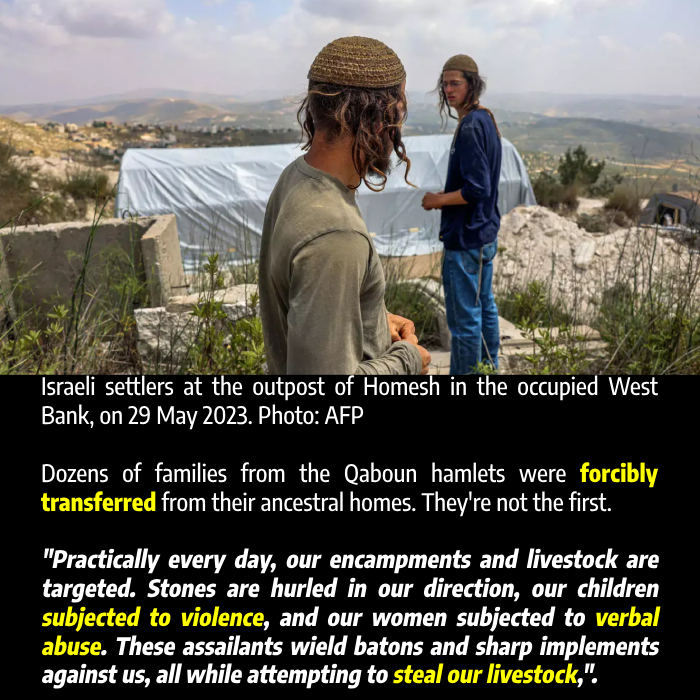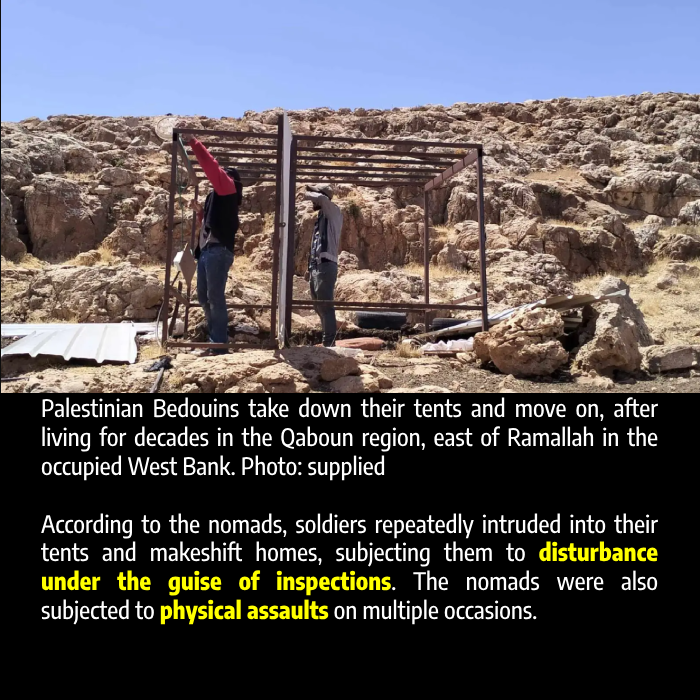By Fayha Shalash in Ramallah, occupied Palestine.

It was no simple task for Suleiman Nasr, a 44-year-old shepherd, to disassemble the tent that sheltered his family of seven. But he had no other choice.
A cluster of Palestinian nomad families, including Nasr’s, had resided for 45 years in the Qaboun hamlets east of Ramallah, within the heart of the occupied West Bank. Some of these families hailed from the lands of the Naqab, which fell under Israeli control as the Negev in 1948.
Today, the nomads are once again compelled to abandon their ancestral lands, forced out due to the incessant onslaught of attacks by both the Israeli army and settlers.
In an interview with Middle East Eye, Nasr expressed the unbearable nature of the settler attacks, which have grown increasingly relentless over the past two months. These assaults originate from the Shilo settlement, strategically positioned between the cities of Ramallah and Nablus. Nasr described these attacks as “systematic”.
“Practically every day, our encampments and livestock are targeted. Stones are hurled in our direction, our children subjected to violence, and our women subjected to verbal abuse. These assailants wield batons and sharp implements against us, all while attempting to steal our livestock,” he said.
At the break of dawn on Monday, the 36 members of the Kaabneh family were forced to disassemble their tents, pack up their belongings, and relocate to an uninhabited area nestled between the villages of Al-Mughayyir and Abu Falah, east of Ramallah. They had no option, if they were to escape the unwelcome presence of the Shilo settlers.
This coerced displacement is a recurring event. In May, 78 children from the Ein Samia community, near the town of Kafr Malik, were forced to depart due to ongoing Israeli transgressions, including the demolition of several of their homes and the only school in the community.
“Our departure from the land we’ve called home for decades was not a matter of choice, but rather one of necessity,” Nasr said. “The Israeli army and settlers left us with no alternative. Regrettably, we found no support forthcoming from any official entity or grassroots organisation.”

According to the nomads, soldiers repeatedly intruded into their tents and makeshift homes, subjecting them to disturbance under the guise of inspections. The nomads were also subjected to physical assaults on multiple occasions.
Around 300 Palestinians form the core of this nomad community, living in tents and rudimentary structures fashioned from tin and mud.
Israel’s assertion that these are illegal constructions, and the day-to-day actions of Israeli forces, have led all nomad families in northeastern Ramallah to consolidate in a single location.
Settler attacks ‘grimly routine’
Across the occupied West Bank, nomad communities share a common struggle against Israel’s discriminatory policies. The majority find themselves located in the C classified areas, falling under Israeli authority as stipulated by the Oslo Agreement.
One such consolidated community resides in the Masafer Yatta region, to the south of Hebron. Here, 20 interconnected nomad groups are in a persistent battle against Israeli efforts to displace them, in order to enlarge the surrounding settlements and annex the nomads’ ancestral lands.
‘I was born here, and generations before me called this land home, long before the Israeli occupation emerged’
– Samir Hamamdeh
For Samir Hamamdeh, 57, and his family, livestock is the only livelihood. However, their existence is marred by the relentless imposition of Israeli measures designed to coerce them into surrendering their lands.
“I was born here, and generations before me called this land home, long before the Israeli occupation emerged. Post-1967, life became a ceaseless struggle due to unending Israeli hostilities. We endure our days here, but it’s hardly a life to speak of,” he said.
During the 1970s, the seeds of Israel’s settlement enterprise took root in the southern Hebron region, as it voraciously consumed vast stretches of Palestinian land. The expansion then extended its tendrils toward the pristine landscapes of Masafer Yatta, transforming these idyllic areas into Israeli settlements.

Israel’s National Security Minister Itamar Ben Gvir hugs a supporter as he arrives at the site of a reported attack in the Israeli settlement of Maale Adumim in the occupied West Bank, on 1 August 2023. Photo: AFP
Opposition leader accuses MP in Ben Gvir’s party of ‘supporting terrorism’ after statement backing suspected murderers.
READ: Israel’s Ben Gvir defends settlers suspected of killing Palestinian as ‘heroes’
In defiance of multiple verdicts issued by Israeli courts, mandating the eviction of these communities, the Palestinian residents say they will stand firm, unwavering in their commitment to remain. In response, Israel has unshackled its settlers and soldiers, unleashing a campaign of oppression to force their departure.
“Settler incursions onto our lands and sporadic assaults have become grimly routine. Our livestock are pilfered, and on occasion, brutally slain,” Hamamdeh told MEE.
“They obstruct our movements and restrict our access, while soldiers storm our dwellings under the guise of hunting smugglers and those lacking permits. Destruction of property and physical abuse, marked by beatings and derogatory language, have become our daily ordeal,” he recounted.
‘Sterilisation’ policy
The Israeli assault on nomad territories isn’t a recent phenomenon, but a battle that has persisted over many years.
Suhail Khalilieh, director of the Settlement Monitoring Unit at the Applied Research Institute in Jerusalem (ARIJ), shed light on the plan for the expulsion of nomad populations in East Jerusalem, paving the way for the realisation of the E-1 project, part of the Greater Jerusalem expansion scheme.
“For over two decades, Israel has articulated its intention to ‘sterilise’ the regions east of Jerusalem, the southern Hebron zone, and the vicinity of the Jordan Valley,” Khalilieh told MEE, using a term frequently used by Israeli authorities in reference to the expulsion of nomads.
‘The systemic abuse faced by the Bedouins in the West Bank mirrors the atrocities committed against the Bedouins in Naqab and Beer Alsabaa during 1948’
– Suhail Khalilieh, ARIJ
“This strategic manoeuvre is designed to displace the Bedouin communities, confining them to prescribed enclaves. The reality far surpasses what the media portrays. The ongoing battle against them is fierce, characterised by Israel’s utilisation of every conceivable tactic to forcibly expel them,” he added.
As per the 2017 statistics unveiled by the United Nations Office for the Coordination of Humanitarian Affairs in the Occupied Palestinian Territories (OCHA), a stark reality emerges regarding the potential forced displacement of 46 nomad communities in the central West Bank.
Of these communities, 26 find themselves within the jurisdiction of the Jerusalem governorate – a total of 4,856 nomads. These people grapple with dire living conditions, marked by severe deficits in fundamental services like water and electricity. Their challenges are further compounded by limited access to essential educational and healthcare facilities.
The data furnished by the UN underscores that over 70 percent of the residents within these communities are refugees who were expelled by Israel in 1948 from their original homes in southern occupied Palestine. A staggering 90 percent of them rely on livestock grazing as their primary source of livelihood. Most of their homes have been marked for demolition, with a staggering 85 percent lacking access to both water and electricity.
Khalilieh pointed out that Israel’s approach includes an array of distressing tactics, including the demolition of homes and schools, the senseless killing of livestock, the relentless harassment of shepherds and farmers, the deliberate burning of crops, violent physical assaults that can be deadly, the sabotage of wells, and obstructing the building of crucial infrastructure. These calculated methods, the ARIJ claims, unequivocally amount to the crime of ethnic cleansing.
“The Palestinian Bedouin communities stand as an impediment to the expansion of settlements. Consequently, they endure these brutal assaults with impunity,” Khalilieh said.
“The systemic abuse faced by the Bedouins in the West Bank mirrors the atrocities committed against the Bedouins in Naqab and Beer Alsabaa in occupied Palestine during 1948.”
Source: Middle East Eye. 11 Aug 2023